Abstract
Vagotomy and gastric surgery have been implicated in gallstone formation, although the association remained unproven. Gallbladder function was investigated in 11 patients with a pyloroplasty and truncal vagotomy, 5 with a subtotal gastrectomy, and 16 healthy controls. Gallbladder filing and emptying in response to cholecystokinin (CCK 0.01 U/kg min), when quantitated by 99m-Tc-HIDA cholescintigraphy, did not show any differences between the control and the surgical groups. In each group, over 70% of hepatic activity partitioned into the gallbladder rather than the duodenum, filing the gallbladder at 2.1%/min. Gallbladder emptying began five minutes after initiating the CCK infusion and ejected half of its contents during the next 12 minutes. Biliary lipid compositions was determined in 20 patients who underwent elective pyloroplasty and vagotomy for duodenal ulcer disease. Gallbladder bile collected at surgery was compared to bile-rich duodenal fluid aspirated eight months after recovery from surgery. Cholesterol saturation decreased significantly (p less than 0.05) both in terms of the relative cholesterol content (6.9% leads to 5.2%) and the lithogenic index (1.24 leads to 0.84). To determine if a selective increase in one of the conjugated bile salts could explain this improvement, bile salt composition was analyzed by high pressure liquid chromatography in eight patients and showed no change after surgery. Thus, vagotomy does not adversely affect gallbladder function, but instead improves cholesterol solubility.
Full text
PDF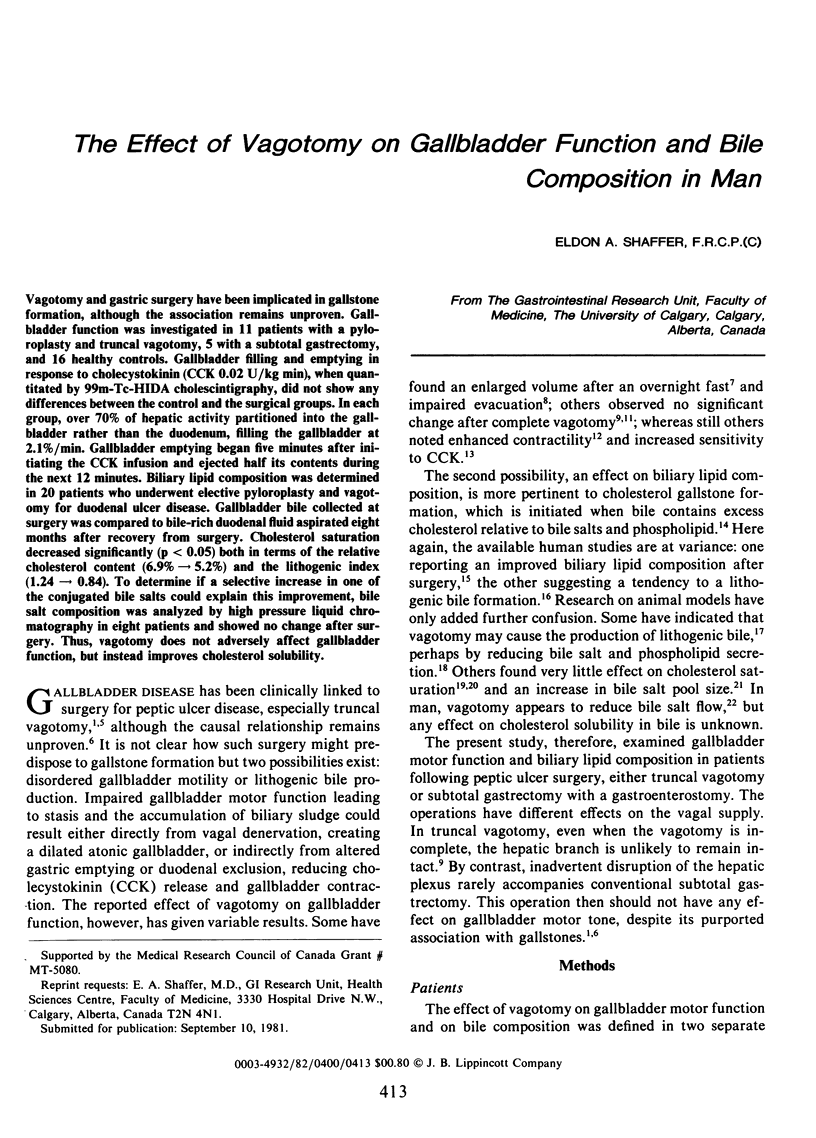
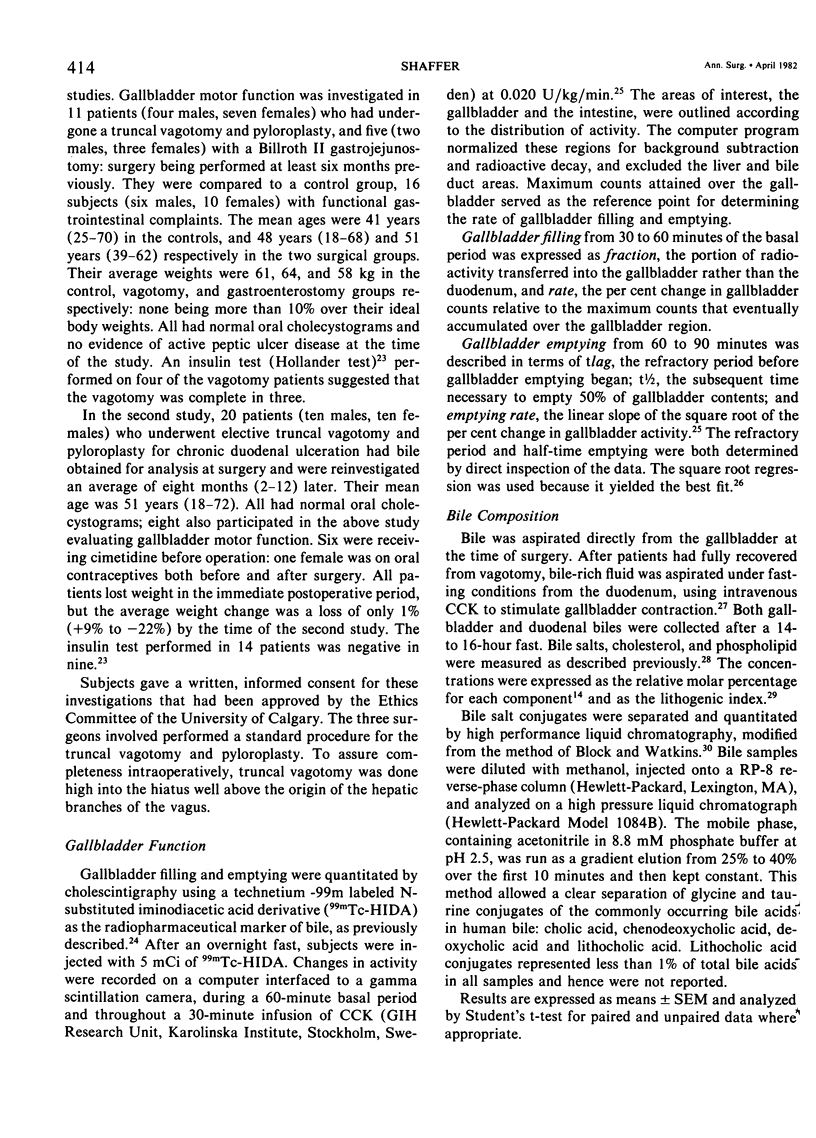

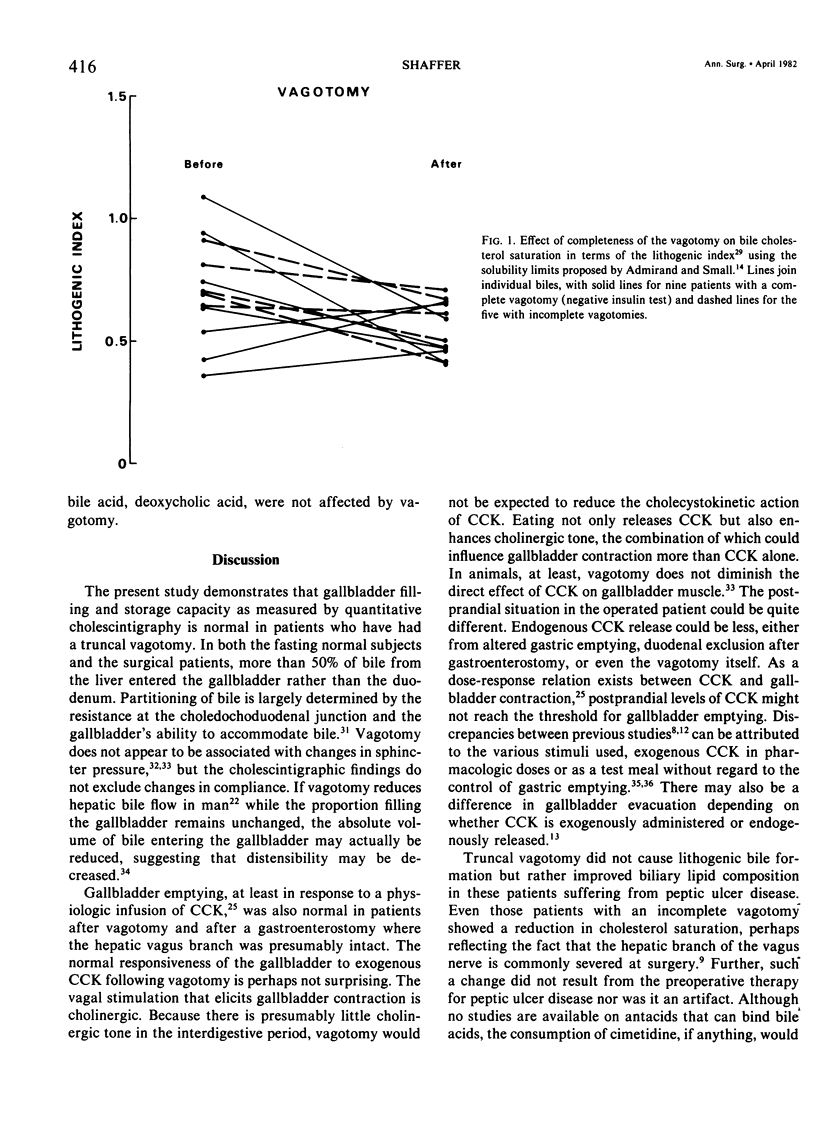
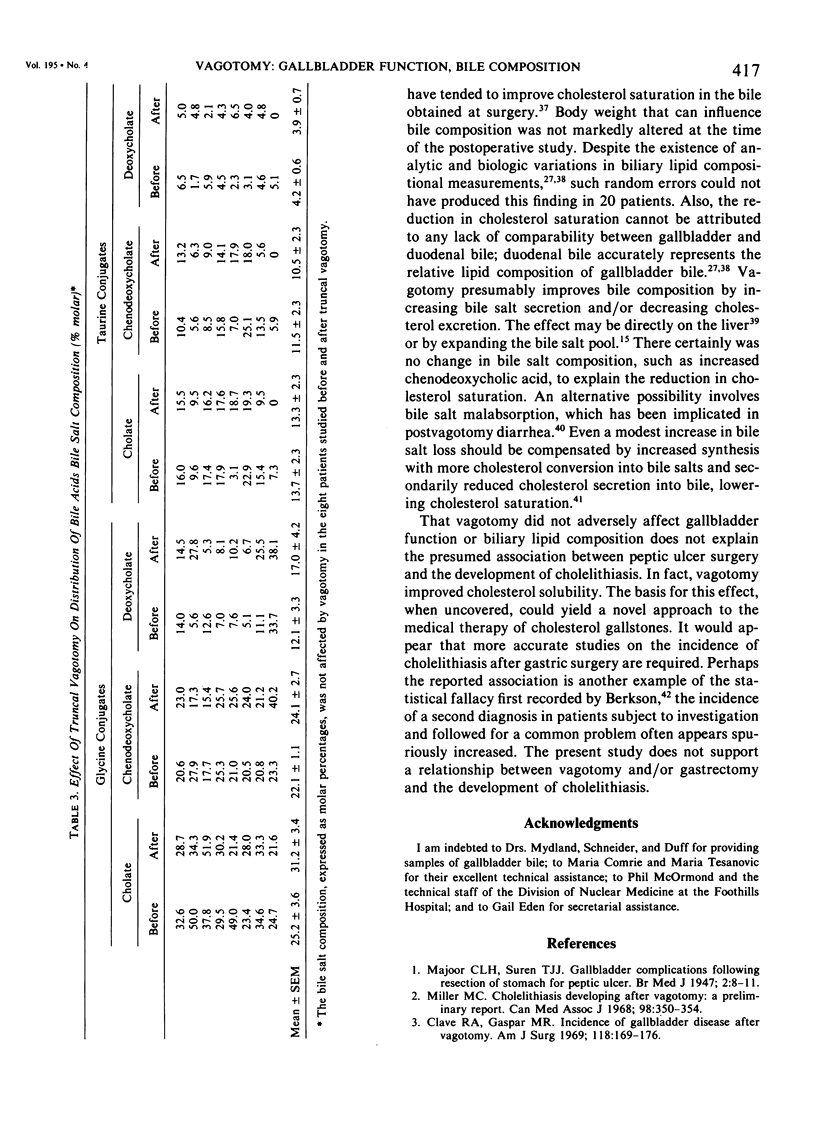
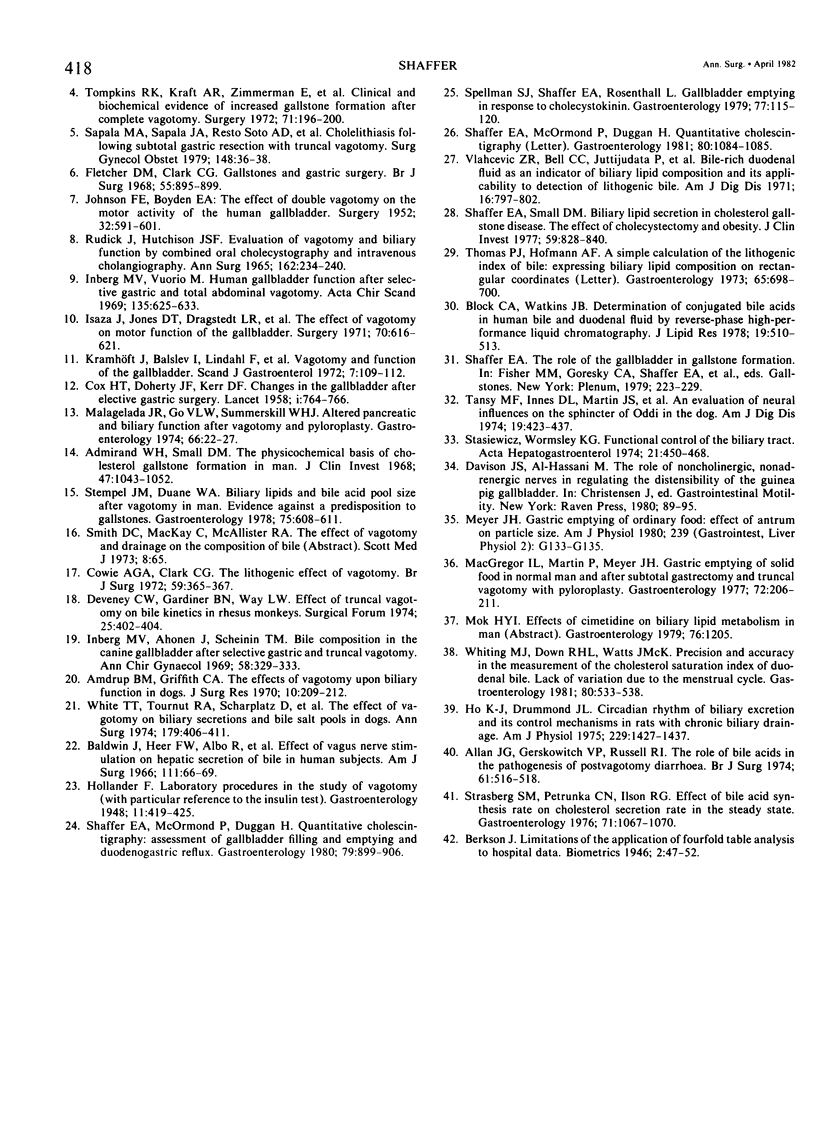
Selected References
These references are in PubMed. This may not be the complete list of references from this article.
- Admirand W. H., Small D. M. The physicochemical basis of cholesterol gallstone formation in man. J Clin Invest. 1968 May;47(5):1043–1052. doi: 10.1172/JCI105794. [DOI] [PMC free article] [PubMed] [Google Scholar]
- Allan J. G., Gerskowitch V. P., Russell R. I. The role of bile acids in the pathogenesis of postvagotomy diarrhoea. Br J Surg. 1974 Jul;61(7):516–518. doi: 10.1002/bjs.1800610704. [DOI] [PubMed] [Google Scholar]
- Amdrup B. M., Griffith C. A. The effects of vagotomy upon biliary function in dogs. J Surg Res. 1970 May;10(5):209–212. doi: 10.1016/0022-4804(70)90033-8. [DOI] [PubMed] [Google Scholar]
- Baldwin J., Heer F. W., Albo R., Peloso O., Ruby L., Silen W. Effect of vagus nerve stimulation on hepatic secretion of bile in human subject. Am J Surg. 1966 Jan;111(1):66–69. doi: 10.1016/0002-9610(66)90344-8. [DOI] [PubMed] [Google Scholar]
- Bloch C. A., Watkins J. B. Determination of conjugated bile acids in human bile and duodenal fluid by reverse-phase high-performance liquid chromatography. J Lipid Res. 1978 May;19(4):510–513. [PubMed] [Google Scholar]
- COX H. T., DOHERTY J. F., KERR D. F. Changes in the gallbladder after elective gastric surgery. Lancet. 1958 Apr 12;1(7024):764–766. doi: 10.1016/s0140-6736(58)91575-7. [DOI] [PubMed] [Google Scholar]
- Clave R. A., Gaspar M. R. Incidence of gallbladder disease after vagotomy. Am J Surg. 1969 Aug;118(2):169–176. doi: 10.1016/0002-9610(69)90116-0. [DOI] [PubMed] [Google Scholar]
- Cowie A. G., Clark C. G. The lithogenic effect of vagotomy. Br J Surg. 1972 May;59(5):365–367. doi: 10.1002/bjs.1800590508. [DOI] [PubMed] [Google Scholar]
- Deveney C. W., Gardiner B. N., Way L. W. Effect of truncal vagotomy on bile kinetics in rhesus monkeys. Surg Forum. 1974;25(0):402–404. [PubMed] [Google Scholar]
- Everson G. T., Kern F., Jr Quantitative cholescintigraphy. Gastroenterology. 1981 May;80(5 Pt 1):1084–1085. [PubMed] [Google Scholar]
- Fletcher D. M., Clark C. G. Gall-stones and gastric surgery. A review. Br J Surg. 1968 Dec;55(12):895–899. doi: 10.1002/bjs.1800551205. [DOI] [PubMed] [Google Scholar]
- HOLLANDER F. Laboratory procedures in the study of vagotomy with particular reference to the insulin test. Gastroenterology. 1948 Oct;11(4):419–425. [PubMed] [Google Scholar]
- Ho K. J., Drummond J. L. Circadian rhythm of biliary excretion and its control mechanisms in rats with chronic biliary drainage. Am J Physiol. 1975 Nov;229(5):1427–1437. doi: 10.1152/ajplegacy.1975.229.5.1427. [DOI] [PubMed] [Google Scholar]
- Inberg M. V., Ahonen J., Scheinin T. M. Bile composition in the canine gallbladder after selective gastric and truncal vagotomy. Ann Chir Gynaecol Fenn. 1969;58(4):329–333. [PubMed] [Google Scholar]
- Inberg M. V., Vuorio M. Human gallbladder function after selective gastric and total abdominal vagotomy. Acta Chir Scand. 1969;135(7):625–633. [PubMed] [Google Scholar]
- Isaza J., Jones D. T., Dragstedt L. R., Woodward E. R. The effect of vagotomy on motor function of the gallbladder. Surgery. 1971 Oct;70(4):616–621. [PubMed] [Google Scholar]
- JOHNSON F. E., BOYDEN E. A. The effect of double vagotomy on the motor activity of the human gall bladder. Surgery. 1952 Sep;32(3):591–601. [PubMed] [Google Scholar]
- Kramhöft J., Balslev I., Lindahl F., Backer O. G. Vagotomy and function of the gall-bladder. Scand J Gastroenterol. 1972;7(2):109–112. [PubMed] [Google Scholar]
- MAJOOR C. L. H., SUREN T. J. J. Gall-bladder complications following resection of the stomach for peptic ulcer. Br Med J. 1947 Jul 5;2(4513):8–11. doi: 10.1136/bmj.2.4513.8. [DOI] [PMC free article] [PubMed] [Google Scholar]
- MacGregor I. L., Martin P., Meyer J. H. Gastric emptying of solid food in normal man and after subtotal gastrectomy and truncal vagotomy with pyloroplasty. Gastroenterology. 1977 Feb;72(2):206–211. [PubMed] [Google Scholar]
- Malagelada J. R., Go V. L., Summerskill W. H. Altered pancreatic and biliary function after vagotomy and pyloroplasty. Gastroenterology. 1974 Jan;66(1):22–27. [PubMed] [Google Scholar]
- Meyer J. H. Gastric emptying of ordinary food: effect of antrum on particle size. Am J Physiol. 1980 Sep;239(3):G133–G135. doi: 10.1152/ajpgi.1980.239.3.G133. [DOI] [PubMed] [Google Scholar]
- Miller M. C. Cholelithiasis developing after vagotomy: a preliminary report. Can Med Assoc J. 1968 Feb 17;98(7):350–354. [PMC free article] [PubMed] [Google Scholar]
- RUDICK J., HUTCHISON J. S. EVALUATION OF VAGOTOMY AND BILIARY FUNCTION BY COMBINED ORAL CHOLECYSTOGRAPHY AND INTRAVENOUS CHOLANGIOGRAPHY. Ann Surg. 1965 Aug;162:234–240. doi: 10.1097/00000658-196508000-00010. [DOI] [PMC free article] [PubMed] [Google Scholar]
- Sapala M. A., Sapala J. A., Soto A. D., Bouwman D. L. Cholelithiasis following subtotal gastric resection with truncal vagotomy. Surg Gynecol Obstet. 1979 Jan;148(1):36–38. [PubMed] [Google Scholar]
- Shaffer E. A., McOrmond P., Duggan H. Quantitative cholescintigraphy: assessment of gallbladder filling and emptying and duodenogastric reflux. Gastroenterology. 1980 Nov;79(5 Pt 1):899–906. [PubMed] [Google Scholar]
- Shaffer E. A., Small D. M. Biliary lipid secretion in cholesterol gallstone disease. The effect of cholecystectomy and obesity. J Clin Invest. 1977 May;59(5):828–840. doi: 10.1172/JCI108705. [DOI] [PMC free article] [PubMed] [Google Scholar]
- Smith D. C., MacKay C., McAllister R. A. The effect of vagotomy and drainage on the composition of bile. Scott Med J. 1973 Mar;18(2):65–65. doi: 10.1177/003693307301800209. [DOI] [PubMed] [Google Scholar]
- Spellman S. J., Shaffer E. A., Rosenthall L. Gallbladder emptying in response to cholecystokinin. A cholescintigraphic study. Gastroenterology. 1979 Jul;77(1):115–120. [PubMed] [Google Scholar]
- Stasiewicz J., Wormsley K. G. Functional control of the biliary tract. Acta Hepatogastroenterol (Stuttg) 1974 Dec;21(6):450–468. [PubMed] [Google Scholar]
- Stempel J. M., Duane W. C. Bilary lipids and bile acid pool size after vagotomy in man. Evidence against a predisposition to gallstones. Gastroenterology. 1978 Oct;75(4):608–611. [PubMed] [Google Scholar]
- Strasberg S. M., Petrunka C. N., Ilson R. G. Effect of bile acid synthesis rate on cholesterol secretion rate in the steady state. Gastroenterology. 1976 Dec;71(6):1067–1070. [PubMed] [Google Scholar]
- Tansy M. F., Innes D. L., Martin J. S., Kendall F. M. An evaluation of neural influences on the sphincter of oddi in the dog. Am J Dig Dis. 1974 May;19(5):423–437. doi: 10.1007/BF01255606. [DOI] [PubMed] [Google Scholar]
- Thomas P. J., Hofmann A. F. Letter: A simple calculation of the lithogenic index of bile: expressing biliary lipid composition on rectangular coordinates. Gastroenterology. 1973 Oct;65(4):698–700. [PubMed] [Google Scholar]
- Tompkins R. K., Kraft A. R., Zimmerman E., Lichtenstein J. E., Zollinger R. M. Clinical and biochemical evidence of increased gallstone formation after complete vagotomy. Surgery. 1972 Feb;71(2):196–200. [PubMed] [Google Scholar]
- Vlahcevic Z. R., Bell C. C., Jr, Juttijudata P., Swell L. Bile-rich duodenal fluid as an indicator of biliary lipid composition and its applicability to detection of lithogenic bile. Am J Dig Dis. 1971 Sep;16(9):797–802. doi: 10.1007/BF02239307. [DOI] [PubMed] [Google Scholar]
- White T. T., Tournut R. A., Scharplatz D., Kavlie H., Olson A. D., Hopton D. S. The effect of vagotomy on biliary secretions and bile salt pools in dogs. Ann Surg. 1974 Apr;179(4):406–411. doi: 10.1097/00000658-197404000-00004. [DOI] [PMC free article] [PubMed] [Google Scholar]
- Whiting M. J., Down R. H., Watts J. M. Precision and accuracy in the measurement of the cholesterol saturation index of duodenal bile. Lack of variation due to the menstrual cycle. Gastroenterology. 1981 Mar;80(3):533–538. [PubMed] [Google Scholar]


